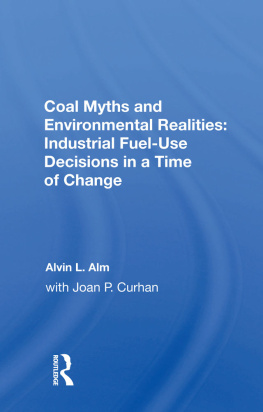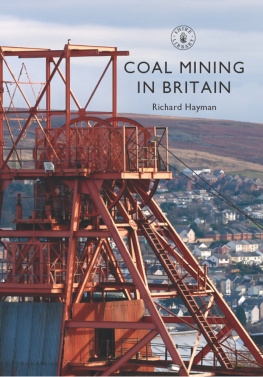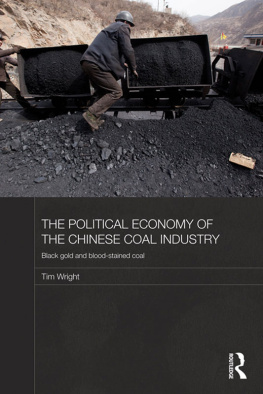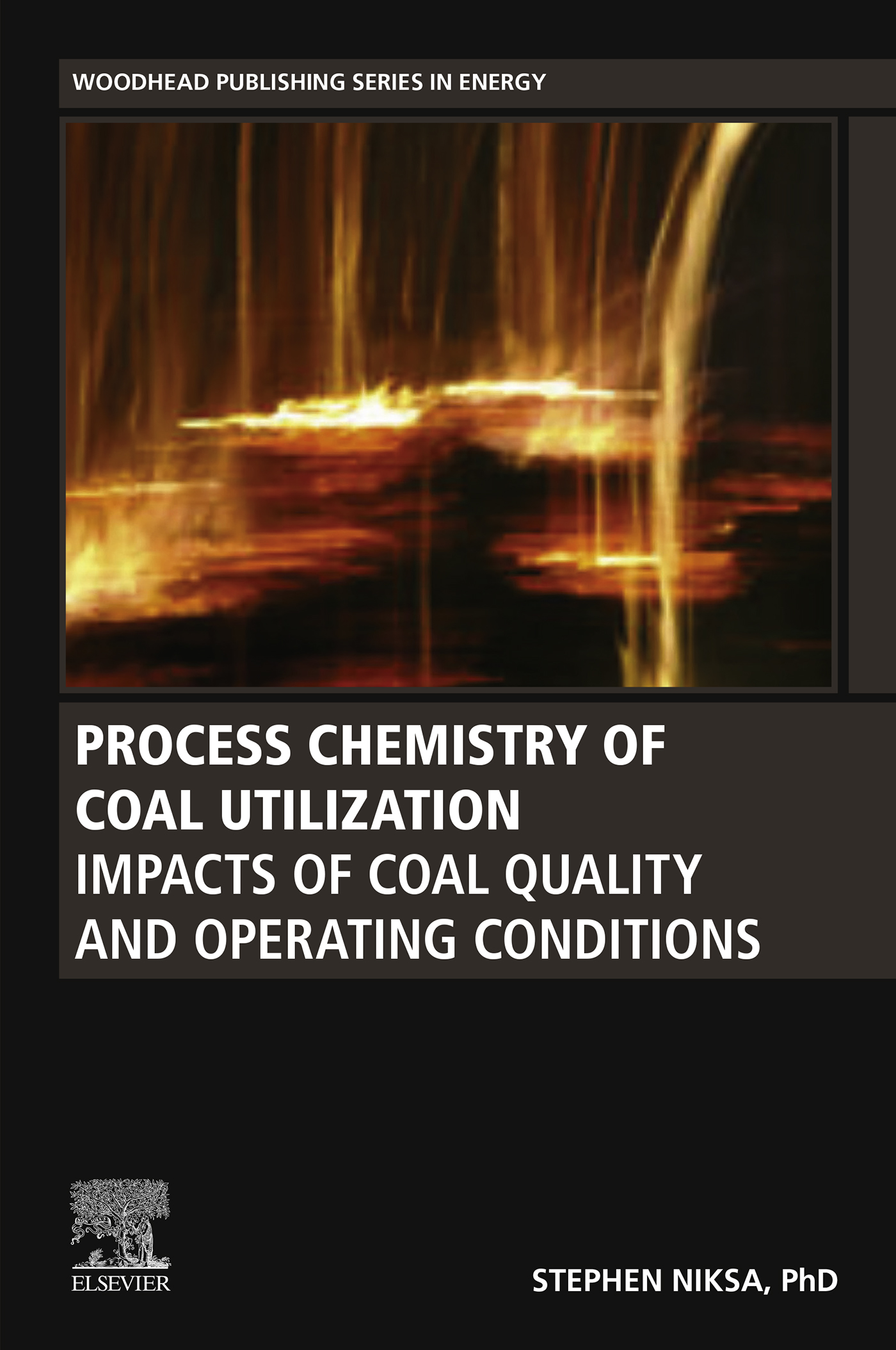Process Chemistry of Coal Utilization
Impacts of Coal Quality and Operating Conditions
First Edition
Stephen Niksa, PhD

Copyright
Woodhead Publishing is an imprint of Elsevier
The Officers Mess Business Centre, Royston Road, Duxford, CB22 4QH, United Kingdom
50 Hampshire Street, 5th Floor, Cambridge, MA 02139, United States
The Boulevard, Langford Lane, Kidlington, OX5 1GB, United Kingdom
2020 Elsevier Ltd. All rights reserved.
No part of this publication may be reproduced or transmitted in any form or by any means, electronic or mechanical, including photocopying, recording, or any information storage and retrieval system, without permission in writing from the publisher. Details on how to seek permission, further information about the Publisher's permissions policies and our arrangements with organizations such as the Copyright Clearance Center and the Copyright Licensing Agency, can be found at our website: www.elsevier.com/permissions.
This book and the individual contributions contained in it are protected under copyright by the Publisher (other than as may be noted herein).
Notices
Knowledge and best practice in this field are constantly changing. As new research and experience broaden our understanding, changes in research methods, professional practices, or medical treatment may become necessary.
Practitioners and researchers must always rely on their own experience and knowledge in evaluating and using any information, methods, compounds, or experiments described herein. In using such information or methods they should be mindful of their own safety and the safety of others, including parties for whom they have a professional responsibility.
To the fullest extent of the law, neither the Publisher nor the authors, contributors, or editors, assume any liability for any injury and/or damage to persons or property as a matter of products liability, negligence or otherwise, or from any use or operation of any methods, products, instructions, or ideas contained in the material herein.
Library of Congress Cataloging-in-Publication Data
A catalog record for this book is available from the Library of Congress
British Library Cataloguing-in-Publication Data
A catalogue record for this book is available from the British Library
ISBN: 978-0-12-818713-5 (print)
ISBN: 978-0-12-818714-2 (online)
For information on all Woodhead publications visit our website at https://www.elsevier.com/books-and-journals

Publisher: Brian Romer
Acquisition Editor: Maria Convey
Editorial Project Manager: Aleksandra
Production Project Manager: Debasish Ghosh
Cover Designer: Greg Harris
Typeset by SPi Global, India
Preface
Coal is used worldwide to produce electricity, process heat, synthetic feedstocks and chemicals, metallurgical cokes for steelmaking, and specialty chemicals. The scale of these industries and the scope of their utilization technologies are among the broadest that humanity has ever devised. Whether you size it in tonnage or kilowatt-hours or monetary value, the coal enterprise is gigantic. Even while the enterprise shrinks in the developed world to contain its environmental impact, it is also expanding at a phenomenal pace across Asia, and coming to life in Africa. For as far into the future as any of us can foresee, coal utilization will keep its place among the essential technologies that can advance societies into the modern world.
During this author's career, how we manage coal utilization technologies and perform R&D has been radically transformed. Coal characterization had been rooted in the mining industry, and pursued by analogy to rocks with optical instruments and a battery of simple, standardized tests in retorts and muffle furnaces. Two OPEC oil shocks during the 1970s prompted a complete reorganization of the coal R&D community in the United States. The commercial focus immediately shifted toward synthetic fuels and feedstocks while the government, for the first time, mobilized basic research scientists to characterize coal with the most advanced diagnostics of the day, and to unravel its conversion mechanisms at the molecular level. Indeed, most of our current understanding of coal constitution was revealed during this period.
As coals molecular features were exposed, a hope rose that the engineering support for coal technologies would soon be brought to parity with recent advances in petrochemical engineering. The search for reaction mechanisms was on! I vividly remember the largest hotel conference halls in Pittsburgh and Washington, District of Columbia packed to standing room capacity for project review meetings sponsored by the US Department of Energy (DoE). Audiences reacted to the latest test data and modeling approaches with vigorous debates, because the scientific findings were being fast-tracked into technology development programs. Managers at America's largest petrochemical, aerospace, and defense contractors perceived huge payoffs down the road, while they struggled up the steep learning curves for coal handling and processing. But by the middle of the 1980s, petroleum markets had relaxed to an agreeable equilibrium and government funding in the American coal community took a nosedive.
Other coal research communities took their turn on the leading edge. Australians made seminal contributions to char oxidation kinetics throughout the 1970s and 1980s, then introduced and rapidly developed computational fluid dynamics (CFD) simulations for coal-fired furnaces. The physicochemical architecture in these first CFD simulations remains in place today, while CFD grew into a cornerstone of engineering design throughout the world. The German community led from the middle of the 1980s through the beginning of the 1990s with support from the mining industry, making major contributions to pyrolysis and gasification mechanisms, and to testing at elevated pressures. Japanese academic researchers made major contributions in coal liquefaction, and also compiled the databases on pyrolysis, oxidation, and gasification kinetics that clearly revealed the coal quality impacts for the first time. But by the dawn of the Clinton Administration in the United States, the American community had dwindled and largely withdrawn into DoE's National Energy Technology Laboratories.
English, German, Portuguese, and American engineers rapidly expanded applications of CFD furnace simulations through the 1990s by focusing them toward NO X emissions control with coordinated testing at laboratory and pilot scale. Through the same period, researchers in the United States, United Kingdom, and Australia largely unraveled the scientific basis for ash fouling and slagging problems in utility furnaces, and Northern Europeans described how CFBCs operate. Italians and Scandinavians brought fluidized bed processing into the mainstream. From the mid-1990s through the mid-2000s, Japan re-focused its academic research on support for CFD, to extend these capabilities to gasification and other high-pressure technologies. The Australian community shared this focus on gasification technology development via CFD over most of the same time period, and also pressed forward in the rational basis to manage boiler fouling and slagging problems.















